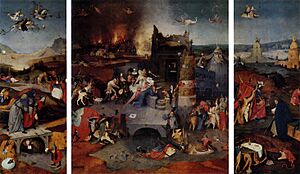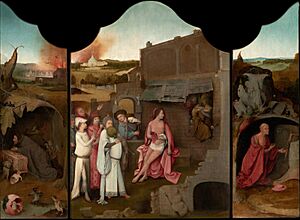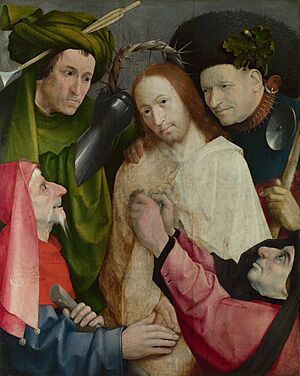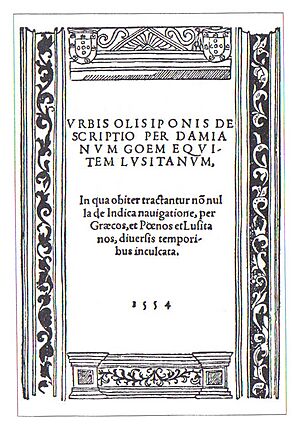Damião de Góis facts for kids
Quick facts for kids
Damião de Góis
|
|
|---|---|
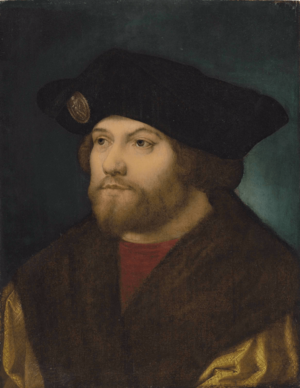
Portrait of Damião de Góis, 16th century, after an engraving by Albrecht Dürer
|
|
| Born | 2 February 1502 Alenquer, Portugal
|
| Died | January 30, 1574 (aged 71) Alenquer, Portugal
|
| Nationality | Portuguese |
| Occupation | Humanist philosopher, historian, chronicler, archivist, general |
| Signature | |
Damião de Góis (born February 2, 1502 – died January 30, 1574) was an important Portuguese thinker. He was a humanist philosopher and historian. He was born in Alenquer, Portugal.
Góis was a friend and student of the famous scholar Erasmus. He worked for the King of Portugal. In 1523, King John III of Portugal sent him to Antwerp. There, he became a secretary for the Portuguese factory. This was a special office for trade. He also wrote one of the first reports about Ethiopian Christianity.
Contents
Who was Damião de Góis?
Góis was born into a noble family in Alenquer, Portugal. His family had served the Portuguese kings for a long time. His father, Rui Dias de Góis, worked for the Duke of Aveiro. His mother, Isabel Gomes de Limi, came from a family of merchants.
Early Life and Travels
Around 1518, Góis joined the court of King Manuel I of Portugal. Later, King John III of Portugal sent him to Antwerp in 1523. His job was to manage the Portuguese trading post there.
From Antwerp, Góis traveled a lot. He visited many countries like Poland, Germany, France, and England. He met many important people during his travels. These included Erasmus, Thomas More, and Martin Luther. Erasmus even hosted him in Freiburg for several months. Góis also studied at the Universities of Padua and Leuven.
Góis was a very open-minded person. He wrote about different topics, like the Sami people (also called "Lapps"). He also translated old classic books into Portuguese. One of these was Cicero’s Cato maior de senectute, about old age.
He also composed some music and collected paintings. He owned three paintings by the famous artist Hieronymous Bosch.
His Writings and Challenges
In the 1530s, Góis translated an important Portuguese text into Latin. This text was about an Ethiopian embassy to Portugal. It included a famous letter from the Ethiopian Queen Eleni.
In 1538, he published a translation of the Biblical book Ecclesiastes into Portuguese. That same year, he married Joana van Hargen from the Netherlands.
In 1540, he published his most famous book, Fides, religio, moresque Aethiopum. This means "Ethiopian faith, religion, and customs." The book became very popular across Europe. It was read by both Catholic and Protestant people.
However, this book also caused problems for Góis. The powerful Portuguese Cardinal Henry did not like it. Cardinal Henry was the head of the Portuguese Inquisition. The Inquisition was a powerful religious court. He banned Góis's book in Portugal. The Jesuits also criticized Góis. They accused him of following Lutheranism and being a student of Erasmus.
Return to Portugal
In 1542, Góis was living in Louvain. The French army attacked the town. Góis was put in charge of defending Louvain. He saved the town but was captured and held prisoner for nine months. He had to pay a lot of money to be set free. For his bravery, he received a special award from Charles V.
He returned to Portugal in 1545. He hoped to become a teacher to the king's son. But he did not get the job because of the accusations against him by the Inquisition.
In 1548, Góis was made the High Guardian of the Torre do Tombo. This was the Royal Archives of Portugal. Ten years later, Cardinal Henry asked him to write the history of King Manuel I's reign. This became his most important work. However, parts of it were censored. He also wrote a description of Lisbon, called Urbis Olisiponis Descriptio (1554).
In 1570, the Inquisition started a new investigation against him. Góis was sent to live in the Batalha monastery. He died shortly after in Alenquer, in 1574. He was buried in the church of Nossa Senhora da Várzea. Góis had several children.
Representations
- "Melodias estranhas" is an opera about him.
- He was featured on a 1942 Portugal 500 Escudos banknote.
Writings
Damião de Góis wrote many books and translations. Some of his important works include:
- Legatio Magni Indorum Imperatoris Presbyteri Ioannis... (1532): About the embassy of Prester John.
- Fides, religio, moresque Aethiopum... (1540): About the faith and customs of Ethiopians.
- Urbis Olisiponis descriptio (1554): A description of the city of Lisbon.
- Crónica do Felicíssimo Rei D. Manuel (1566–67): A history of King Manuel I's reign.
See also
 In Spanish: Damião de Góis para niños
In Spanish: Damião de Góis para niños


